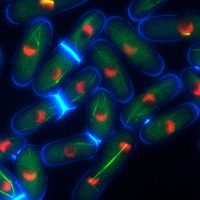
Juan Carlos
García Cortés
Profesor Contratado Doctor
Department: MICROBIOLOGÍA Y GENÉTICA
Institute: INSTITUTO DE BIOLOGÍA FUNCIONAL Y GENÓMICA
Area: Microbiology
Email: cortes@usal.es
Personal web: https://orcid.org/my-orcid?orcid=0000-0002-2395-6668
In my career I focused my studies on the mechanisms that control the cell division and that couple the actomyosin ring contraction and cleavage furrow ingression with the synthesis of the division septum in the fission yeast: 1. Role of glucan synthases in the cell growth and cell division (1999-2006): During my PhD studies at the IMB, CSIC, I studied the role of the beta-glucan synthases Bgs1 and Bgs4 during cytokinesis. I discovered that Bgs1 is responsible for the linear beta-glucan and primary septum formation. This study revealed interesting similarities with plant cytokinesis, where the cell plate callose (linear beta-glucan) is synthetized by a Bgs1 homologue. Furthermore, I found that Bgs4 plays an essential role as the major glucan synthase responsible for preserving the cell integrity. 2. Spatial and temporal control of the cell division by the SIN pathway (2006-09): During my postdoctoral studies at the laboratory of Dr. D. McCollum (UMass, Worcester, USA) I worked in the regulation of cytokinesis by the conserved Hippo/SIN pathway, discovering some of the mechanisms by which this pathway is activated once the chromosomes are segregated, and is inactivated once cytokinesis is completed. 3. Analysis of the role of alpha-glucan in cell division (2010-13): After my incorporation at the IBFG, CSIC, I analysed the role of the alpha-glucan synthase Ags1 during cytokinesis, finding that alpha-glucan is essential for the structural strength of the septum needed to withstand the physical forces generated by the cell turgor pressure during cell abscission. Similarly to Bgs1, these results showed similarities with the lamella pectin (an alpha-linked polysaccharide) which is essential for the adhesion and separation functions in plant cells. 4. Study of the mechanisms that couple ring contraction with septum synthesis and furrow ingression at early anaphase (2013-present) This is my current research. In the recent years I collaborated with Dr. J. C. Ribas, Dr. P. Perez and several international groups. We discovered that the Bgs4 beta-glucan is required for stable ring positioning before the start of septation. During furrow ingression the Bgs4 glucan couples septation with ring and membrane ingression, revealing similarities with a proposed function in cytokinesis for the extracellular matrix of animal cells. Furthermore, we found that septum is not involved in the controversial furrow ingression force erroneously assigned to the septum synthesis. This study demonstrated that septation is not the cause but the consequence of furrow ingression. My recent studies have shown that cooperation between the stable anchorage of the actomyosin ring through the conserved proteins Cdc15, Pxl1, and Sbg1, and the Bgs1 activity is required for ring maintenance and septum formation. I also discovered that contrarily to the existing model assumed for all the eukaryotic cells, furrow ingression starts at early anaphase in a size-dependent manner, long before spindle breakage and telophase onset as it is currently assumed. This shows that mitosis and cytokinetic furrow ingression are not concatenated but simultaneous events. In addition to my studies in cell division, I have gained a deep knowledge into the mechanisms of action of three different families of specific inhibitors of the cell wall beta-glucan synthesis with pharmaceutical interest, revealing for first time two natural intrinsic resistant glucan synthases.









